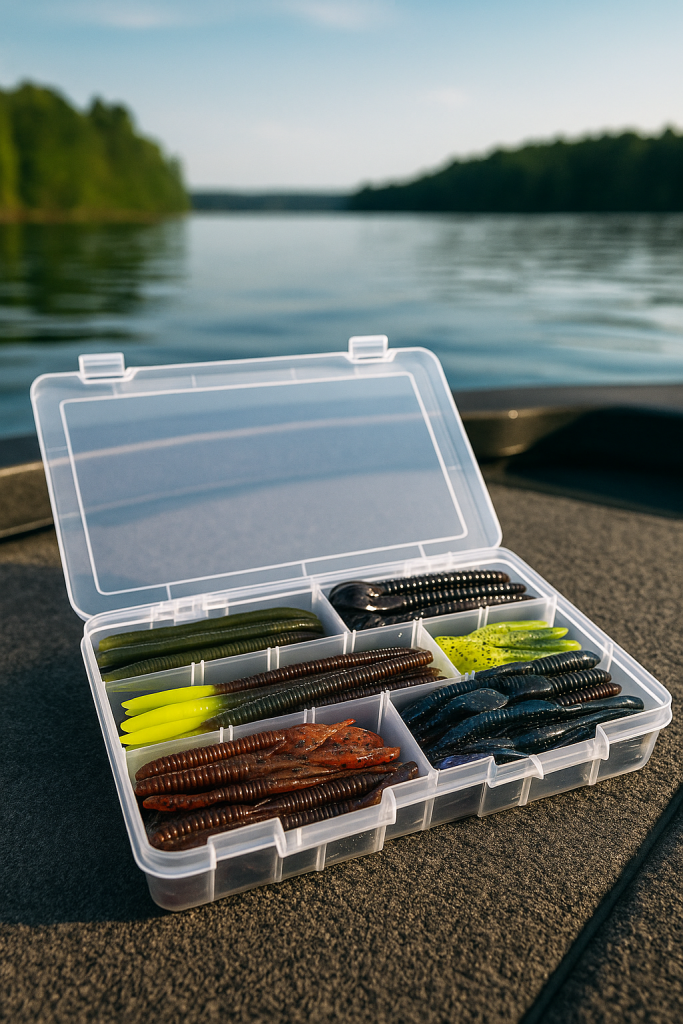
Best Colors for Plastic Worms in Clear, Stained, and Murky Water (2025 Bass Fishing Guide)
Quick Answer
If you want the short answer before we dive deep:
-
Clear Water: Natural, translucent colors like Green Pumpkin, Watermelon Red Flake, and Natural Shad.
-
Stained Water: Brighter, contrasting colors like June Bug, Chartreuse Pepper, and Plum.
-
Murky/Dark Water: Dark, solid profiles like Black/Blue Flake, Solid Black, or Junebug Red.
Color choice isn’t just about “looking pretty” — it’s about matching light penetration and visibility so bass can actually find and commit to your bait.
Want the full breakdown on rigs, hook sizes, and presentations? Check out our complete Plastic Worms & Creature Baits Master Guide.
Quick View Chart – Water Clarity & Seasonal Color Picks
| Water Clarity | Spring | Summer | Fall | Winter |
|---|---|---|---|---|
| Clear | Green Pumpkin, Watermelon Red Flake | Natural Shad, Baby Bass | Pumpkinseed, Watermelon Candy | Smoke w/ Purple Flake |
| Stained | June Bug, Plum | Chartreuse Pepper, Oxblood | Red Bug, Green Pumpkin w/ Chartreuse Tip | Grape, Blue Fleck |
| Murky/Dark | Black/Blue Flake, Junebug Red | Black Neon, Solid Black | Black w/ Red Flake | Black/Blue Flake, Sapphire Blue |
Why Worm Color Matters in Bass Fishing
A bass’s world is ruled by light and shadow — and unlike us, they don’t care about “color accuracy,” they care about contrast and visibility.
Here’s the science:
-
Clear water: Light penetrates deep, so subtle colors work best. Too much flash can spook fish.
-
Stained water: Light penetration is reduced, so colors need more contrast to be seen.
-
Murky water: Very little light; bass hunt silhouettes and vibration first.
Bass also have cones and rods in their eyes, giving them limited color perception in certain light. In low light, they see contrast better than color.
For more on rigging techniques and lure types, visit the Plastic Worms & Creature Baits Master Guide.
Best Colors for Clear Water Bass Fishing
When you can see 5+ feet into the water, bass are wary. This is where you “match the hatch” and keep things subtle.
Top Picks:
-
Green Pumpkin – The undisputed king for clear water.
-
Pairs well with Texas or Wacky rigs.
-
Works year-round.
-
Check price on Amazon
-
-
Watermelon Red Flake – Adds a subtle sparkle without being too flashy.
-
Great in sunny conditions.
-
Check price on Amazon
-
-
Natural Shad – Perfect for clear reservoirs with shad forage.
-
Excellent for drop shot rigs.
-
Check price on Amazon
-
-
Baby Bass – Mimics juvenile bass; bass love cannibalizing their young.
-
Great post-spawn color.
-
Check price on Amazon
-
Best Colors for Stained Water Bass Fishing
In water with 2–4 feet visibility, go with colors that hold contrast but still look natural.
Top Picks:
-
June Bug – Deep purple with green flake; visible in almost all light.
-
Legendary in Southern waters.
-
Check price on Amazon
-
-
Chartreuse Pepper – Greenish body with chartreuse flake; stands out without being neon.
-
Works well in partly cloudy days.
-
Check price on Amazon
-
-
Plum – Bass can’t resist it in summer/fall transition.
-
Best on Carolina rigs.
-
Check price on Amazon Creature & Worm
-
-
Green Pumpkin – Classic two-tone that triggers reaction bites.
Best Colors for Murky/Dark Water Bass Fishing
When visibility is under 1 foot, go dark and bold. Bass key on silhouettes.
Top Picks:
-
Black/Blue Flake – The night fishing king.
-
Solid Black – Creates maximum silhouette in muddy water.
-
Junebug – Adds a bit of flash without losing contrast.
-
Sapphire Blue – Stands out in extreme low-light or stained current water.
Seasonal Adjustments
Spring: Use brighter versions of natural colors to trigger pre-spawn aggression.
Summer: Lean toward more translucent/natural tones in clear water; in heat, bass can be wary.
Fall: Baitfish colors dominate — silver, shad, baby bass.
Winter: Stick to dark and subtle; cold water slows bass, so you want a slow-moving, easy target.
Special Situations
Post-Front Conditions: Go subtle; bass are lethargic.
Night Fishing: Black or black/blue for silhouette.
Highly Pressured Lakes: Natural colors with minimal flake to avoid spooking fish.
Pro Tips for Choosing Worm Colors
-
Match your trailer color if fishing jigs.
-
Experiment daily — bass preferences change with light and forage shifts.
-
Use dye pens to add chartreuse tips on the fly.
-
Carry multiple shades of your “confidence color.”
Common Mistakes in Color Selection
-
Overcomplicating — you don’t need every color on the market.
-
Ignoring water clarity.
-
Using too much flake in ultra-clear water.
Pros & Cons of Focusing on Worm Color
Pros
- Improves bite consistency in tough conditions
- Allows fine-tuning for seasonal patterns
- Helps match local forage
- Boosts confidence in bait choice
Cons
- Too many options can overwhelm beginners
- Minor factor compared to presentation
- Can lead to overthinking instead of fishing
Final Verdict
Worm color isn’t everything — but it’s the final touch that can turn a slow day into a limit day. Think of it as fine-tuning the radio signal so the bass “station” comes in crystal clear.
Start with Green Pumpkin (clear water), June Bug (stained water), and Black/Blue Flake (murky water). Add seasonal tweaks, and you’ve got a winning lineup that will catch bass anywhere in North America.
This guide is part of our complete Plastic Worms & Creature Baits Master Guide — your one-stop resource for catching bass on soft plastics.
About the Author
Brian Bahr is the founder of Bark & Brass, a no-BS outdoor gear and tactics resource built for everyone from first-time anglers to seasoned outdoorsmen. With decades of fishing and hunting experience, Brian combines real-world know-how with technical depth, delivering guides that feel like you’re learning from a buddy on the boat — without the sales pitch.